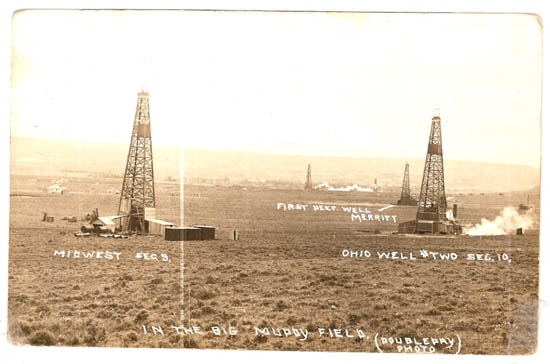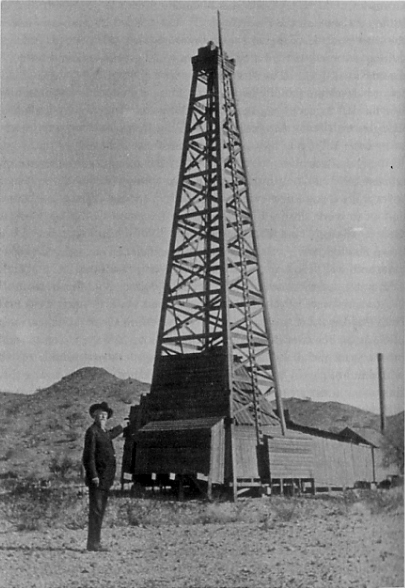
Roughnecks after capping an oil well in Wyoming’s Salt Creek field, circa 1920s. American Heritage Center, University of Wyoming.
Petroleum exploration in Wyoming had gone on since reports of oil seeps in 1832 when Wyoming Prairie Oil & Gas Company joined the search in 1917.
Fur trappers in Wyoming Territory first reported finding oil seeps near Salt Creek. Tales of a “Great Tar Spring” had led to the earliest hand-dug oil wells there during the Civil War.
“The first recorded oil sale in Wyoming occurred along the Oregon Trail when, in 1863, enterprising entrepreneurs sold oil as a lubricant to wagon-train travelers” explains Wyohistory.org. “The oil came from Oil Mountain Springs some 20 miles west of present-day Casper.”
By 1884, six years before statehood, Mike Murphy, an oilman from Pennsylvania, used a steam-powered cable-tool rig to drill 300 feet deep and complete Wyoming’s first official oil well. Read more in First Wyoming Oil Wells.
With modest capitalization of $36,000 in 1917, Wyoming Prairie Oil & Gas Company incorporated in Cheyenne, Wyoming. The company soon had 640 acres under lease in the state’s Big Muddy oilfield.
The Big Muddy, discovered in 1916, will eventually produce more than 30 million barrels of high quality oil, according to a state historical marker on U.S. 20 near Glenrock.
“Strata here were arched upward at the time the Rocky Mountains originated about 60 million years ago, to form anticline, or dome. Because oil is lighter than water, it rose to the crest of the dome where it was trapped in pore spaces between sand grains,” the marker explains.
Wyoming Prairie Oil & Gas and other exploration companies then sought the Wall Creek sand, which lies at a depth of near 3,000 feet. Another producing zone, the Dakota sand waited at about 4,000 feet.
As with many speculative petroleum exploration ventures, Wyoming Prairie Oil & Gas repeatedly increased its capitalization by issuing stock to get funds for drilling new wells. The last recorded was in October 1917, when shareholders voted to increase capitalization to $1 million.

Typical circa 1918 cable-tool rigs drill for oil in the region where Wyoming Prairie Oil & Gas Company explored. Photo courtesy Niobrara County Library.
To attract investors, Wyoming Prairie Oil & Gas enthusiastically adverised its leases and their potential riches in newspapers.
About this time, a similarly named company arrived from Kansas. The Prairie Oil & Gas Company, a larger exploration and production company, had been a subsidiary of Standard Oil of New Jersey until the U.S. Supreme Court broke up Standard Oil in 1911.
This Prairie Oil & Gas Company had grown aggressively since leaving Standard Oil. It tried to secure a charter to do business in Wyoming, but because the name was already registered to Wyoming Prairie Oil & Gas Company, it could not.
The two companies began negotiations. The business publication Cumulative Daily Digest of Corporation News reported that the larger company tried to convince Wyoming Prairie Oil & Gas to amend its charter and change its name.
“Unless such an arrangement is made the big Kansas company will be unable to secure from the state of Wyoming a charter enabling it to operate in Wyoming as the Prairie Oil & Gas Company, the Wyoming Prairie Oil & Gas Company holding a right, by virtue of its prior incorporation, to to protest the chartering of a concern with a name so similar to its name,” the publication reported.
Meanwhile, Wyoming Prairie Oil & Gas drilled a couple of exploratory “wildcat” wells.
“The Wyoming Prairie Oil and Gas Company, located on section 17-34-76, have fully established their winter camp with an eighty-four-foot derrick completed and all preparations ready for a winter of active drilling, reported the Niobrara County News on January 3, 1918.
One well was soon reported to be 1,500 feet deep in the “Lost Soldier Field” 35 miles north of Rawlins. It had a “showing of oil,” the company reported.
The company also declined to change its name, thereby preventing its Kansas competitor from operating in Wyoming under the name of Prairie Oil & Gas Company. But just a few years later, its competitor (newly incorporated as Kasoming Oil Company to pursue its Wyoming interests) proved more successful in the state’s oilfields.

W.F. Cody stands by one of his cable-tool wells drilled near Cody, Wyoming. Photo courtesy Buffalo Bill Center of the West.
Although still enthusiastically promoted in advertisements, by 1924 Wyoming Prairie Oil & Gas had exhausted its funds without completing enough commercially viable wells. A business journal reported the company’s demise.
“Last fall this company was dissolved,” noted the Oil Trade. Interestingly, another name change occurred when “attorneys for the Prairie immediately files articles of incorporation for the Prairie Oil & Gas Company of Wyoming.”
Ads and news about Wyoming Prairie Oil & Gas can be found in the Wyoming Newspaper Project. Other heavily promoted companies included ones founded by W.F. “Buffalo Bill” Cody and discredited Arctic explorer Frederick Cook. Cody drilled wells in the Shoshone Anticline near Cody. Read about him in Buffalo Bill Shoshone Oil Company.
In 1917 – the same year Prairie Oil & Gas was incorporated – Cook conducted geological explorations in Wyoming for his newly formed Texas Eagle Oil Company. His fraudulent claims led to several failed oil company ventures, a mail fraud conviction and jail time. See Arctic Explorer turns Oil Promoter.
___________________________________________________________________________________
The stories of other attempts to join petroleum exploration booms (and avoid busts) can be found in an updated series of research at Is my Old Oil Stock worth Anything?
___________________________________________________________________________________
Please support the American Oil & Gas Historical Society and this website with a donation.


